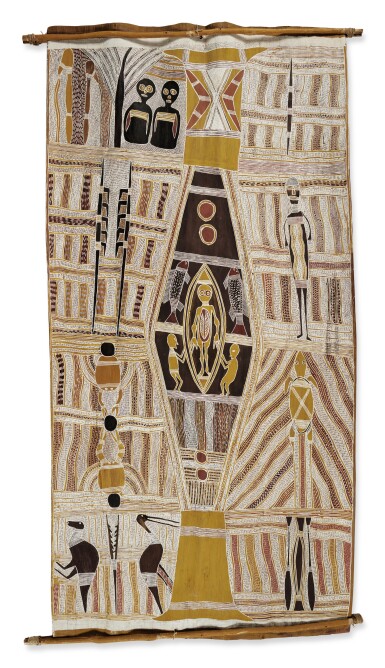
Property from the Collection of Mr. Ler de Vries, Ponte Vedra, Florida
Banapana Maymuru
Two Bark Paintings
Auction Closed
May 20, 09:03 PM GMT
Estimate
6,000 - 9,000 USD
Lot Details
Description
Banapana Maymuru
circa 1944 - 1982
Two Bark Paintings
Natural earth pigments on eucalyptus bark
Larger painting: Untitled (Yingapungapu - Burial Ground)
67 ⅝ in x 32 ⅝ in (171.8 cm x 82.9 cm)
Smaller painting: Milngiyawuy, the Milky Way
49 ⅛ in x 15 in (124.8 cm x 38. 1 cm)
Painted in Yirrkala, Northeast Arnhem Land
Mr. Ler de Vries, Ponte Vedra, Florida, acquired from the above in the early 1970s
Thence by descent to the present owner
Untitled (Yingapungapu - Burial Ground), circa 1972
Untitled (Yingapungapu - Burial Ground) depicts one of the main rituals of the Manggalili clan in northeast Arnhem Land, the funeral of the deceased. The oval shaped burial ground, a sculpture made in the sand and known as the yingapungapu, is the focus of this painting. The first yingapungapu was created in Wangarr (Dreaming) times by two ancestors of the Manggalili, the Nyapililngu sisters whose brothers were fishing and hunting turtles out to sea when a storm capsized their boat. One brother’s body was washed back to shore. The Nyapililngu dug a pit in the shape of a shallow dish used for burying fish bones and placed their brother’s body in the grave. The circles within the ground sculpture symbolise freshwater wells where mourners are ritually cleansed at the end of the ceremony.
The two sisters appear in the upper section of the painting, beside an anvil-shaped thunder cloud of the monsoon season with boomerangs that release lightning and thunder. A digging stick, a symbol of womanhood appears to the right. To the left of the women are the hunter’s spear throwers and barbed spears, below which are two crabs emerging from holes in the sand; the latter are symbolic of the cleansing of the deceased’s bones. In turn, the crabs are devoured by the pied heron seen beside a barbed spear and an emu. In the opposite section a turtle appears above an elliptical form that echoes that of the yingapungapu, but here represents the brothers’ boat in between their paddles.
Milngiyawuy, the Milky Way, c.1972
The Yolngu describe Milngiyawuy the Milky Way as a river of stars in the sky which are manifestations of the spirits of deceased clan members. The constellations represent creator ancestors in Wangarr times (in the Dreaming) such as Baru the Crocodile. The hand-written description of the imagery attached to the reverse of the sheet of bark reads:
"MILKY WAY STORY
One day two fishermen […] went far out to sea in their bark canoe. They caught a big rock cod and were homeward bound when a big storm broke out and huge waves pounded their canoe and eventually broke it up. The two men tried to swim to shore but the distance was too great. One fisherman drowned (you can see his body in this painting) and [the other] though he reached the beach at Djarrakpi had swallowed too much water and was so exhausted that he also died. Today they can all be seen as stars in the Milky Way. The middle panel of this bark shows the Milky Way where the crocodile, the bark canoe and the rock cod can be seen today. Top right panel is Manggalili design for storm clouds that came up and helped swamp the canoe (bottom left) and its paddles (bottom right). Top left corner is hollow log used by Manggalili people to bury their dead. Above the paddles is a large sea creature that came about when Barama [ancestral hero] made a large fish trap basket which floated down into Manggalili country changing into the sea creature."
While Banapana Maymuru may not have intended Milngiyawuy, the Milky Way and Untitled (Yingapungapu - Burial Ground) as a diptych, the paintings are complementary.
You May Also Like










